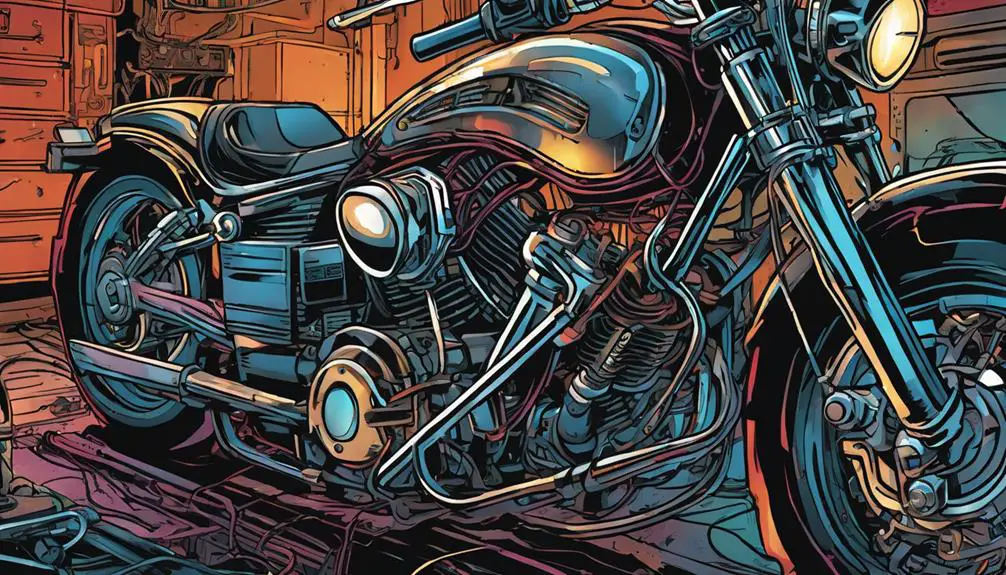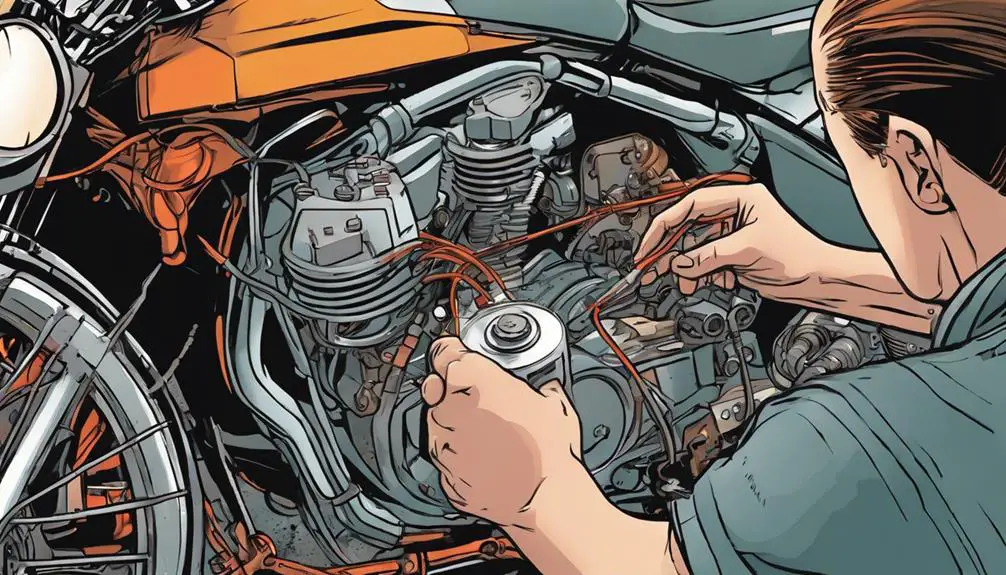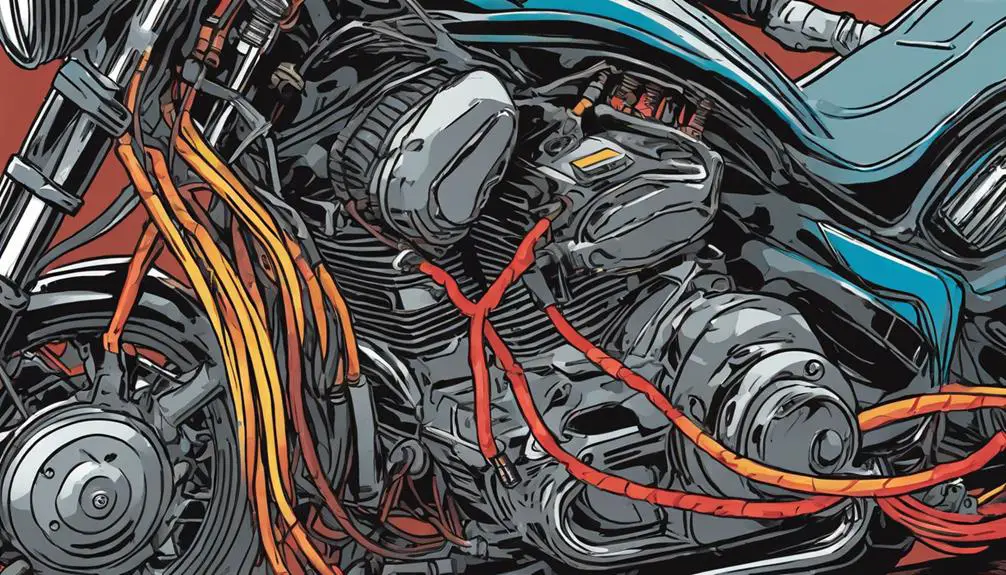When it comes to your motorcycle's electrical system, a little attention can go a long way. You should regularly check the battery, alternator, and wiring connections to guarantee everything's functioning properly. Keeping an eye on battery fluid levels and maintaining clean, tight connections can prevent frustrating starting issues. But what happens when you notice something unusual? Understanding how to troubleshoot potential problems is just as important. Let's explore some essential tips that can keep your ride smooth and reliable.
Key Takeaways
- Regularly inspect the battery for corrosion and ensure connections are tight to maintain reliable starting performance.
- Conduct visual inspections of wiring for frayed or damaged insulation to prevent short circuits and electrical failures.
- Frequently check and replace fuses as needed, ensuring replacements match amperage ratings to protect the electrical system.
- Clean battery terminals and connectors to enhance electrical flow and prevent issues caused by corrosion.
Understanding the Electrical System

Your motorcycle's electrical system is vital for its performance, powering everything from the starter motor to the lights. Understanding how it works can give you the freedom to tackle any challenge that comes your way.
At the heart of the system is the battery, providing the initial spark to kickstart your ride. It's important to keep your battery charged and in good condition, as a dead battery can leave you stranded.
Next, you've got the alternator, which generates power while you're cruising. This component keeps your battery charged and guarantees all electrical components run smoothly. Make sure to check your connections and wiring regularly; loose or corroded connections can lead to frustrating issues that rob you of your riding experience.
Lastly, don't forget about the fuses and relays. They act as safety nets, protecting your electrical system from overloads. Regularly inspect them to confirm they're functioning properly.
Common Electrical Issues
When it comes to your motorcycle's electrical system, there are a few common issues you should watch out for.
You'll want to focus on battery maintenance, inspect your wiring regularly, and know how to replace fuses.
Addressing these areas can help keep your ride smooth and reliable.
Battery Maintenance Practices
Proper battery maintenance is vital to prevent common electrical issues that can leave you stranded on the road.
Start by regularly checking your battery's fluid levels. If you have a conventional lead-acid battery, make certain the electrolyte is covering the plates. Low levels can lead to battery failure, so top it up with distilled water when needed.
Next, keep the terminals clean. Corrosion can build up over time, preventing a solid connection. Use a wire brush or battery terminal cleaner to remove any gunk. Don't forget to check for loose connections, as they can disrupt the power flow and cause starting issues.
Charging your battery is also essential. If you ride infrequently, consider investing in a smart charger to maintain the charge without overloading it. Always disconnect the charger when not in use to avoid potential hazards.
Lastly, test your battery regularly, especially before long trips. A multimeter can help you check the voltage, making sure your battery's in good shape.
Wiring Inspection Techniques
Maintaining a motorcycle's battery is just the first step; regular wiring inspections can help you catch common electrical issues before they turn into bigger problems.
Start by checking for frayed wires or exposed insulation. These can lead to short circuits, which can compromise your ride's performance. Look for corrosion on connectors, as it can create resistance and drain your battery faster than you think.
Next, inspect the ground connections. A weak ground can cause erratic behavior in your electrical system. Make sure all connections are tight and clean. Don't forget to check the wiring harness for any signs of wear or damage, especially near moving parts or areas exposed to heat.
It's also wise to pay attention to any unusual smells or sounds while riding. These can be early indicators of electrical issues. If you notice any flickering lights or inconsistent instrument readings, it's time to dive deeper into your wiring.
Fuse Replacement Tips
Fuses play an essential role in protecting your motorcycle's electrical system, so knowing how to replace them can save you from unexpected breakdowns. When you notice electrical issues like dim lights or non-functioning accessories, the first step is to check your fuses.
Locate the fuse box, usually found under the seat or side panel, and take a look at the fuse ratings. If you find a blown fuse, it's vital to replace it with one of the same amperage. Using a higher-rated fuse can lead to more severe electrical problems.
Before removing the blown fuse, make sure your motorcycle is off and the key is removed. You can use a fuse puller or your fingers to carefully take it out. Insert the new fuse gently, ensuring it sits snugly in place.
Once you've replaced it, turn on your motorcycle and check if the electrical components are functioning properly again. Regularly inspecting and replacing fuses not only keeps your bike running smoothly but also empowers you to take charge of its care.
With this knowledge, you're better equipped to embrace the freedom of the open road!
Regular Maintenance Practices

To keep your motorcycle's electrical system running smoothly, you need to adopt regular maintenance practices.
Start by inspecting wiring connections, checking battery health, and cleaning electrical components frequently.
These simple steps can prevent larger issues down the road and enhance your bike's performance.
Inspect Wiring Connections Regularly
Regularly inspecting your motorcycle's wiring connections can prevent electrical issues and enhance overall performance. You want your ride to be as smooth and liberating as the open road itself. By keeping an eye on those connections, you eliminate potential problems before they disrupt your freedom.
Here's what to look for during your inspections:
- Frayed Wires: Check for any exposed or damaged areas that could lead to shorts or failures.
- Loose Connections: Verify all connectors are tight and secure to maintain a solid electrical flow.
- Corrosion: Look for any signs of corrosion, especially at battery terminals and connectors, which can hinder performance.
- Routing Issues: Make sure wires aren't pinched or in contact with hot surfaces, as this can cause insulation wear.
Check Battery Health Frequently
Checking your battery's health frequently guarantees your motorcycle starts reliably and runs smoothly on every ride. It's important to keep an eye on your battery's voltage and overall condition.
Start by testing the voltage with a multimeter; you want to see at least 12.6 volts when the bike is off and around 13.5 to 14.5 volts when it's running. These numbers indicate your battery is healthy and charging properly.
Next, inspect for corrosion on the terminals. A clean connection is crucial for your battery to function effectively. If you spot any corrosion, clean it off with a mixture of baking soda and water. This simple task can prevent poor electrical flow and guarantee your motorcycle remains free and ready for the open road.
Lastly, consider the age of your battery. Most motorcycle batteries last about three to five years. If you're approaching that mark, it might be time to replace it.
Regular checks empower you to ride confidently, knowing your battery won't let you down. Embrace the freedom of the ride by confirming your motorcycle's battery is always up to the challenge!
Clean Electrical Components Regularly
Keeping your electrical components clean helps guarantee your motorcycle runs efficiently and avoids unexpected issues on the road.
Regular maintenance not only enhances performance but also keeps that sense of freedom alive as you ride. Here's how to keep your electrical parts in top shape:
- Inspect Connectors: Look for dirt and corrosion on all electrical connectors. A simple wipe can make a huge difference in ensuring a solid connection.
- Clean Battery Terminals: Use a wire brush to remove any buildup on your battery terminals. Clean connections mean better power delivery, and that's what you want for a smooth ride.
- Wipe Down Switches: Dust and grime can accumulate around switches, causing them to malfunction. A quick clean will keep your controls responsive and reliable.
- Seal and Protect: After cleaning, consider applying a protective spray on exposed components to shield them from moisture and corrosion.
Battery Care and Maintenance
How often do you inspect your motorcycle's battery for signs of corrosion or wear? Regular battery checks are essential for guaranteeing your ride remains free and powerful.
Start by visually examining the terminals and cables; look for any signs of corrosion or loose connections. If you spot white, crusty buildup, don't just ignore it. Clean it off with a mixture of baking soda and water to maintain a solid connection.
Next, check the battery fluid levels if you've got a conventional battery. If they're low, top them off with distilled water. Always handle the battery with care—wear gloves and goggles to protect yourself.
Consider investing in a smart charger, especially during the off-season. This keeps your battery topped off without overcharging, allowing you to release your motorcycle's full potential whenever the open road calls.
Lastly, remember to disconnect the battery if you're storing your bike for a while. Taking these simple steps guarantees your battery stays healthy and ready to ride, granting you the freedom to explore without a hitch.
Embrace the responsibility of maintenance; it's part of the liberation that comes with motorcycle ownership.
Wiring and Connections Inspection

Regularly inspecting your motorcycle's wiring and connections helps guarantee a reliable electrical system that powers your ride smoothly. You don't want to be stranded on the open road due to faulty wiring, so make these checks a part of your routine. Here's what to focus on:
- Visual Inspection: Look for frayed wires, cracked insulation, or any signs of wear. These can lead to short circuits that ruin your ride.
- Connection Tightness: Make sure all connections are snug. Loose connections can create resistance, leading to electrical failures.
- Corrosion Check: Examine battery terminals and connectors for corrosion. Even a small amount can hinder performance and drain your battery's power.
- Grounding Points: Confirm grounding wires are secure and free from rust. A solid ground connection is essential for the entire electrical system to work effectively.
Troubleshooting Electrical Problems
Identifying and resolving electrical problems on your motorcycle can save you from frustrating breakdowns and keep your ride running smoothly.
Start by checking your battery. Confirm it's charged and connections are tight. A weak battery can cause all sorts of chaos, so if it's acting up, consider testing or replacing it.
Next, inspect your fuses. A blown fuse can cut power to crucial components. Replace any that are damaged, but also investigate why they blew—overloaded circuits can lead to bigger issues.
If your lights flicker or fail, check the wiring harness for damage or corrosion. Loose or frayed wires can cause intermittent connections, leading to further problems.
Don't overlook the starter. If the engine won't turn over, it could be a faulty relay or solenoid. Test these components with a multimeter to pinpoint the issue.
Frequently Asked Questions
How Can I Test My Motorcycle's Electrical Components Effectively?
To test your motorcycle's electrical components effectively, start by using a multimeter to check the voltage across the battery terminals.
Verify connections are clean and tight.
Then, inspect fuses and relays for continuity.
For components like the starter and lights, activate them while measuring voltage drop.
If you notice significant drops, you've got a problem.
Don't forget to consult your manual for specific values and procedures tailored to your bike's model.
What Tools Are Essential for Motorcycle Electrical System Care?
When you immerse yourself in the electric heart of your motorcycle, it's like exploring a hidden treasure chest.
To keep that treasure alive, you'll need a few essential tools.
Grab a multimeter to measure voltage and continuity, wire strippers for clean cuts, and a soldering iron for strong connections.
Don't forget insulated screwdrivers and electrical tape; they're your trusty sidekicks in this electrifying adventure.
With these tools, you're ready to release your ride's full potential!
Are There Any Signs of Electrical Issues Before They Occur?
You can often spot signs of electrical issues before they escalate. Look for dimming headlights, flickering gauges, or unusual noises when starting your bike.
If your battery's struggling to hold a charge or you notice corrosion on terminals, those are red flags. Trust your instincts; if something feels off, it probably is.
Regularly checking connections and components can help you catch problems early, keeping your ride smooth and liberating.
What Is the Lifespan of a Motorcycle Battery?
The lifespan of a motorcycle battery typically ranges from three to five years, depending on usage and maintenance.
You've gotta keep an eye on your riding habits and environmental conditions, as extreme temperatures can shorten its life.
Regularly checking connections and charging levels helps you get the most out of it.
If you notice signs of weakness, like slow starts, it's time to contemplate a replacement and stay free on the road.
Can Weather Conditions Affect My Motorcycle's Electrical System?
Absolutely, weather conditions can impact your motorcycle's electrical system.
Extreme temperatures, both hot and cold, can strain your battery and wiring.
Humidity and rain may lead to corrosion, causing electrical failures.
To keep your ride performing at its best, you should regularly check connections and protect them from moisture.
By staying vigilant, you can guarantee your motorcycle remains reliable, no matter the weather.
Embrace the freedom of the road, even in challenging conditions!
Conclusion
As you ride into the sunset, the last thing you want is your trusty motorcycle sputtering to a halt.
By staying vigilant with your electrical system care—checking that battery, inspecting those wires, and replacing fuses—you can avoid the unsettling silence of a dead engine.
Picture yourself cruising confidently, the wind in your hair, knowing you've done everything to guarantee your bike's electrical heart keeps beating strong.
Don't let a small oversight ruin your adventure; stay proactive!